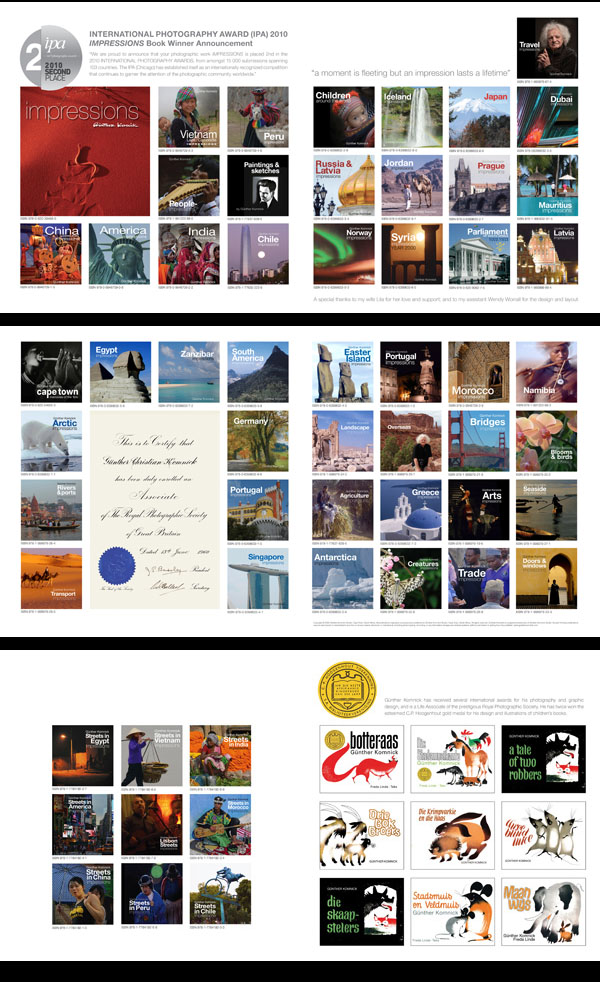Mention the word Zanzibar, (which is derived from the Persian,
Zanjibar meaning "black coast") and in effect you're articulating a byword for exoticism, mystery, history and a self-contained world. Gunther Komnick's present work invites you to explore the sights, sounds and mood of this island, drenched in centuries of history. At times it was at the centre of the world stage, at times it drifted into clandestine obscurity. Inhabited for centuries by Bantu peoples, it caught the eye of the Portuguese, the ever-intrepid discoverers and traders who kept a loose grip on the island for two hundred years from 1504.
In 1698, Zanzibar came under the influence of the Sultanate of Oman and under the various Arab sultanates the slave trade flourished. It is estimated that at one time 50 000 slaves passed through Zanzibar annually. Only in the 19th century did Britain put pressure on Zanzibar, over which it had assumed a protectorate, to put a halt to the notorious slave trade which had ravaged the African Lakes region. Historian Oliver Ransford mentions that among British sailors Zanzibar acquired the unflattering nickname of "Stinkybar", such was the odour that emanated from the slave ships lying at anchor before "unloading" their human cargo.
Germany and Britain vied for control of the island during the 19th century, but ultimately Zanzibar was ruled by sultans, enjoying British protection, with the proviso that the slave trade be stopped. Zanzibar's protectorate status ended in 1963, and soon political divisions on the island came to a head and a revolution in 1964 saw about 20 000 people either being killed or forced to flee, including the famous Queen star, Freddy Mercury, who was born on the island. When Zanzibar joined Tanganyika in 1964 as a semi-autonomous entity, the name of Tanganyika changed to Tanzania, thus signifying the political change.
However, besides slaves and revolution Zanzibar is renowned for its spices, such as cinnamon and cloves, and its historic architecture that spans centuries. In Komnick's lush and evocative images of people in their day-to-day rounds, we see the dense variety of peoples, cultures and colours that enliven the already heady allure of this fabled land. The present book is an invitation to indulge in daydreaming and share in the intimacy of the images in preparation for a visit to this island crucible of world history.
Dr Wilhelm Snyman, Auckland, New Zealand, 2018Mention the word Zanzibar, (which is derived from the Persian, Zanjibar meaning "black coast") and in effect you're articulating a byword for exoticism, mystery, history and a self-contained world. Gunther Komnick's present work invites you to explore the sights, sounds and mood of this island, drenched in centuries of history. At times it was at the centre of the world stage, at times it drifted into clandestine obscurity. Inhabited for centuries by Bantu peoples, it caught the eye of the Portuguese, the ever-intrepid discoverers and traders who kept a loose grip on the island for two hundred years from 1504.
In 1698, Zanzibar came under the influence of the Sultanate of Oman and under the various Arab sultanates the slave trade flourished. It is estimated that at one time 50 000 slaves passed through Zanzibar annually. Only in the 19th century did Britain put pressure on Zanzibar, over which it had assumed a protectorate, to put a halt to the notorious slave trade which had ravaged the African Lakes region. Historian Oliver Ransford mentions that among British sailors Zanzibar acquired the unflattering nickname of "Stinkybar", such was the odour that emanated from the slave ships lying at anchor before "unloading" their human cargo.
Germany and Britain vied for control of the island during the 19th century, but ultimately Zanzibar was ruled by sultans, enjoying British protection, with the proviso that the slave trade be stopped. Zanzibar's protectorate status ended in 1963, and soon political divisions on the island came to a head and a revolution in 1964 saw about 20 000 people either being killed or forced to flee, including the famous Queen star, Freddy Mercury, who was born on the island. When Zanzibar joined Tanganyika in 1964 as a semi-autonomous entity, the name of Tanganyika changed to Tanzania, thus signifying the political change.
However, besides slaves and revolution Zanzibar is renowned for its spices, such as cinnamon and cloves, and its historic architecture that spans centuries. In Komnick's lush and evocative images of people in their day-to-day rounds, we see the dense variety of peoples, cultures and colours that enliven the already heady allure of this fabled land. The present book is an invitation to indulge in daydreaming and share in the intimacy of the images in preparation for a visit to this island crucible of world history.
Dr Wilhelm Snyman, Auckland, New Zealand, 2018
